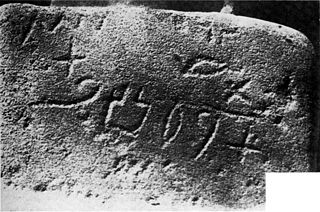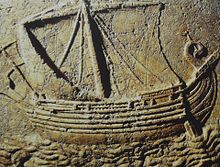The Phoenician alphabet is a consonantal alphabet used across the Mediterranean civilization of Phoenicia for most of the 1st millennium BCE. It was the first mature alphabet, and attested in Canaanite and Aramaic inscriptions found across the Mediterranean region. In the history of writing systems, the Phoenician script also marked the first to have a fixed writing direction—while previous systems were multi-directional, Phoenician was written horizontally, from right to left. It developed directly from the Proto-Sinaitic script used during the Late Bronze Age, which was derived in turn from Egyptian hieroglyphs.
The Canaanite languages, sometimes referred to as Canaanite dialects, are one of three subgroups of the Northwest Semitic languages, the others being Aramaic and Amorite. These closely related languages originate in the Levant and Mesopotamia, and were spoken by the ancient Semitic-speaking peoples of an area encompassing what is today Israel, Jordan, the Sinai Peninsula, Lebanon, Syria, as well as some areas of southwestern Turkey (Anatolia), western and southern Iraq (Mesopotamia) and the northwestern corner of Saudi Arabia.
In the Hebrew Bible, Tophet or Topheth is a location in Jerusalem in the Valley of Hinnom (Gehenna), where worshipers engaged in a ritual involving "passing a child through the fire", most likely child sacrifice. Traditionally, the sacrifices have been ascribed to a god named Moloch. The Bible condemns and forbids these sacrifices, and the tophet is eventually destroyed by king Josiah, although mentions by the prophets Jeremiah, Ezekiel, and Isaiah suggest that the practices associated with the tophet may have persisted.

Tanit or Tinnit was a Carthaginian Punic goddess, and the chief deity of Ancient Carthage, alongside her consort Baal Hammon.
The Paleo-Hebrew script, also Palaeo-Hebrew, Proto-Hebrew or Old Hebrew, is the writing system found in inscriptions of Canaanite languages from the region of Southern Canaan, also known as biblical Israel and Judah. It is considered to be the script used to record the original texts of the Hebrew Bible due to its similarity to the Samaritan script, as the Talmud stated that the Hebrew ancient script was still used by the Samaritans. The Talmud described it as the "Libona'a script", translated by some as "Lebanon script". Use of the term "Paleo-Hebrew alphabet" is due to a 1954 suggestion by Solomon Birnbaum, who argued that "[t]o apply the term Phoenician [from Northern Canaan, today's Lebanon] to the script of the Hebrews [from Southern Canaan, today's Israel-Palestine] is hardly suitable". The Paleo-Hebrew and Phoenician alphabets are two slight regional variants of the same script.

The Proto-Sinaitic script is a Middle Bronze Age writing system known from a small corpus of about 30-40 inscriptions and fragments from Serabit el-Khadim in the Sinai Peninsula, as well as two inscriptions from Wadi el-Hol in Middle Egypt. Together with about 20 known Proto-Canaanite inscriptions, it is also known as Early Alphabetic, i.e. the earliest trace of alphabetic writing and the common ancestor of both the Ancient South Arabian script and the Phoenician alphabet, which led to many modern alphabets including the Greek alphabet. According to common theory, Canaanites or Hyksos who spoke a Canaanite language repurposed Egyptian hieroglyphs to construct a different script.
The history of the alphabet goes back to the consonantal writing system used to write Semitic languages in the Levant during the 2nd millennium BCE. Nearly all alphabetic scripts used throughout the world today ultimately go back to this Semitic script. Its first origins can be traced back to a Proto-Sinaitic script developed in Ancient Egypt to represent the language of Semitic-speaking workers and slaves in Egypt. Unskilled in the complex hieroglyphic system used to write the Egyptian language, which required a large number of pictograms, they selected a small number of those commonly seen in their surroundings to describe the sounds, as opposed to the semantic values, of their own Canaanite language. This script was partly influenced by the older Egyptian hieratic, a cursive script related to Egyptian hieroglyphs. The Semitic alphabet became the ancestor of multiple writing systems across the Middle East, Europe, northern Africa, and Pakistan, mainly through Ancient South Arabian, Phoenician and the closely related Paleo-Hebrew alphabet, and later Aramaic and the Nabatean—derived from the Aramaic alphabet and developed into the Arabic alphabet—five closely related members of the Semitic family of scripts that were in use during the early first millennium BCE.
Cyrus Herzl Gordon was an American scholar of Near Eastern cultures and ancient languages.

The Zayit Stone is a 38-pound (17 kg) limestone boulder dating to the 10th century BCE, discovered on 15 July 2005 at Tel Zayit (Zeitah) in the Guvrin Valley, about 50 kilometres (31 mi) southwest of Jerusalem. The boulder measures 37.5 by 27 by 15.7 centimetres and was embedded in the stone wall of a building. It is the earliest known example of the complete Phoenician or Old Hebrew script as it had developed after the Bronze Age collapse out of the Proto-Canaanite alphabet.

The Punic religion, Carthaginian religion, or Western Phoenician religion in the western Mediterranean was a direct continuation of the Phoenician variety of the polytheistic ancient Canaanite religion. However, significant local differences developed over the centuries following the foundation of Carthage and other Punic communities elsewhere in North Africa, southern Spain, Sardinia, western Sicily, and Malta from the ninth century BC onward. After the conquest of these regions by the Roman Republic in the third and second centuries BC, Punic religious practices continued, surviving until the fourth century AD in some cases. As with most cultures of the ancient Mediterranean, Punic religion suffused their society and there was no stark distinction between religious and secular spheres. Sources on Punic religion are poor. There are no surviving literary sources and Punic religion is primarily reconstructed from inscriptions and archaeological evidence. An important sacred space in Punic religion appears to have been the large open air sanctuaries known as tophets in modern scholarship, in which urns containing the cremated bones of infants and animals were buried. There is a long-running scholarly debate about whether child sacrifice occurred at these locations, as suggested by Greco-Roman and biblical sources.

The Punic people, usually known as the Carthaginians, were a Semitic people who migrated from Phoenicia to the Western Mediterranean during the Early Iron Age. In modern scholarship, the term Punic, the Latin equivalent of the Greek-derived term Phoenician, is exclusively used to refer to Phoenicians in the western Mediterranean, following the line of the Greek East and Latin West. The largest Punic settlement was Ancient Carthage, but there were 300 other settlements along the North African coast from Leptis Magna in modern Libya to Mogador in southern Morocco, as well as western Sicily, southern Sardinia, the southern and eastern coasts of the Iberian Peninsula, Malta, and Ibiza. Their language, Punic, was a dialect of Phoenician, one of the Northwest Semitic languages originating in the Levant.

Lucio Russo is an Italian physicist, mathematician and historian of science. Born in Venice, he teaches at the Mathematics Department of the University of Rome Tor Vergata.
The Bat Creek inscription is an inscribed stone tablet found by John W. Emmert on February 14, 1889. Emmert claimed to have found the tablet in Tipton Mound 3 during an excavation of Hopewell mounds in Loudon County, Tennessee. This excavation was part of a larger series of excavations that aimed to clarify the controversy regarding who is responsible for building the various mounds found in the Eastern United States.
Mark A. S. McMenamin is an American paleontologist and professor of geology at Mount Holyoke College. He has contributed to the study of the Cambrian explosion and the Ediacaran biota.

Ancient Carthage was an ancient Semitic civilisation based in North Africa. Initially a settlement in present-day Tunisia, it later became a city-state and then an empire. Founded by the Phoenicians in the ninth century BC, Carthage reached its height in the fourth century BC as one of the largest metropoleis in the world. It was the centre of the Carthaginian Empire, a major power led by the Punic people who dominated the ancient western and central Mediterranean Sea. Following the Punic Wars, Carthage was destroyed by the Romans in 146 BC, who later rebuilt the city lavishly.
The Phoenician Ship Expedition is a re-creation of a 6th-century BCE Phoenician voyage conceived by Philip Beale. The replica of an ancient Phoenician ship departed from Syria in August 2008, to sail through the Suez Canal, around the Horn of Africa, and up the west coast of Africa, through the Strait of Gibraltar and across the Mediterranean to return to Syria. The objective of the expedition was to prove that ships built by the ancient Phoenicians could withstand the conditions around the African coastline.

Phoenicia, or Phœnicia, was an ancient Semitic thalassocratic civilization originating in the coastal strip of the Levant region of the eastern Mediterranean, primarily located in modern Lebanon. The territory of the Phoenicians expanded and contracted throughout history, with the core of their culture stretching from Arwad in modern Syria to Mount Carmel in modern Israel covering the entire coast of modern Lebanon. Beyond their homeland, the Phoenicians extended through trade and colonization throughout the Mediterranean, from Cyprus to the Iberian Peninsula.

Ancient Semitic-speaking peoples or Proto-Semitic people were speakers of Semitic languages who lived throughout the ancient Near East and North Africa, including the Levant, Mesopotamia, the Arabian Peninsula and Carthage from the 3rd millennium BC until the end of antiquity, with some, such as Arabs, Arameans, Assyrians, Jews, Mandaeans, and Samaritans having a continuum into the present day.

The Canaanite and Aramaic inscriptions, also known as Northwest Semitic inscriptions, are the primary extra-Biblical source for understanding of the society and history of the ancient Phoenicians, Hebrews and Arameans. Semitic inscriptions may occur on stone slabs, pottery ostraca, ornaments, and range from simple names to full texts. The older inscriptions form a Canaanite–Aramaic dialect continuum, exemplified by writings which scholars have struggled to fit into either category, such as the Stele of Zakkur and the Deir Alla Inscription.

Phoenician–Punic literature is literature written in Phoenician, the language of the ancient civilization of Phoenicia, or in the Punic language that developed from Phoenician and was used in Ancient Carthage. It is surrounded by an aura of mystery due to the few preserved remains. All that is left is a series of inscriptions, few of which are of a purely literary nature, coins, fragments of Sanchuniathon's History and Mago's Treaty, the Greek translation of the voyage of Hanno the Navigator and a few lines in the Poenulus by Plautus.













